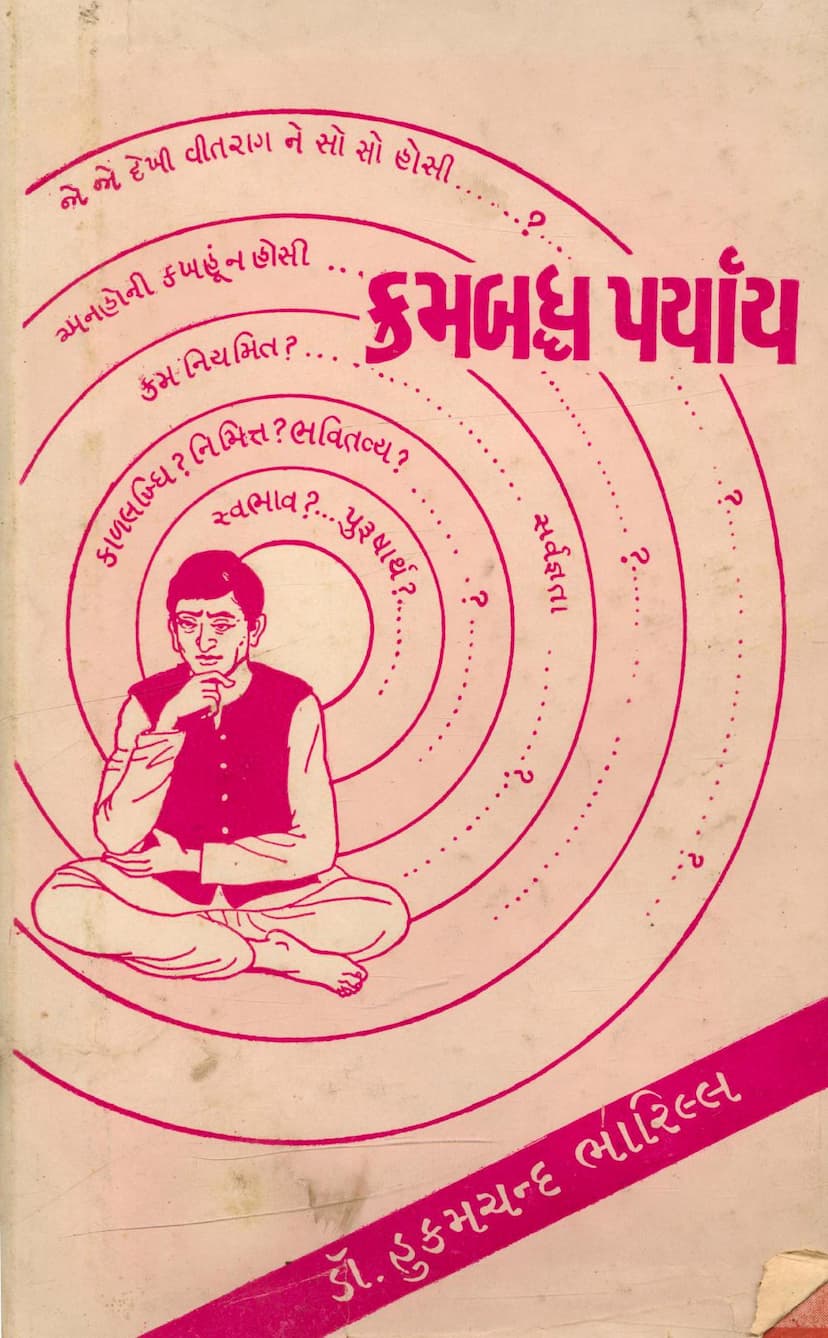Krambaddh Paryay
Added to library: September 2, 2025

Summary
Here is a comprehensive summary of the Jain text "Krambaddh Paryay" based on the provided pages:
Book Title: Krambaddh Paryay (Meaning: Sequentially Determined States/Modes) Author: Dr. Hukamchand Bharilla Translator: B. Vrajlal Girdharbhai Shah Publisher: Digambar Jain Mumukshu Mandal Core Subject: The book delves into the fundamental Jain principle of "Krambaddh Paryay," which asserts that all phenomena and events in the universe occur in a strictly determined, sequential order.
Key Themes and Arguments:
-
The Nature of Reality: The text posits that every entity in the universe is characterized by production (utpād), decay (vyay), and permanence (dhrauvya). Each moment, new states (paryay) are produced and existing ones decay, while the underlying substance (dravya) remains constant.
-
The Principle of Order: "Krambaddh Paryay" is presented as the ultimate resolution to the question of whether these transformations are governed by an inherent, fixed sequence or if they can occur arbitrarily. The book argues that every phenomenon unfolds according to a precise, pre-determined order. What state will arise, in which substance, at what time, is all fixed. This ordered transformation is the essence of "Krambaddh Paryay."
-
The Role of Omniscience (Sarvajñatā): The text strongly relies on the concept of omniscience (Sarvajñatā) to establish the validity of "Krambaddh Paryay." It argues that the determined sequence of transformations was directly perceived and known by the omniscient beings (Kevalis). Their knowledge, which encompasses all past, present, and future states of every entity, validates this orderly unfolding of reality. If the omniscient ones' knowledge were not accurate, it would cease to be true knowledge.
-
Omniscience as a Knower, Not a Cause: The book clarifies that omniscience does not cause these ordered transformations; rather, the ordered unfolding is an intrinsic nature of the substance itself. Omniscience merely knows this inherent order. The relationship between omniscience and "Krambaddh Paryay" is one of illumination (ghotak-ghotya), not cause-effect.
-
Addressing the Fear of Determinism and Loss of Effort (Purushartha): A significant portion of the text addresses the common apprehension that accepting a determined order might lead to fatalism and a lack of individual effort (purushartha).
- Order vs. Disorder: The authors argue that accepting a determined sequence does not lead to chaos but rather to the realization of a beautiful, underlying order.
- Accountability: The text explains that if an offender is destined to commit a crime, they are also destined to face the consequences (punishment). The idea that "it was bound to happen" cannot be used as an excuse to escape punishment when it arrives. Similarly, if suffering in hell is destined due to certain actions, that destiny cannot be escaped.
- Effort in the Determined Path: The book emphasizes that every state of every substance arises through its own inherent potential and effort. No soul is ever devoid of effort. The concept of "Krambaddh Paryay" does not negate the role of effort; rather, it reframes it within the context of a determined sequence. The ignorance of this determined system leads to misinterpreting effort.
-
Reconciling Determinism with Free Will (Purushartha): The book strives to reconcile the concept of a determined order with the Jain emphasis on self-effort. It clarifies that the determined order is not solely based on time-destiny (kal-niyati) but on the confluence of five factors: substance (dravya), place (kshetra), time (kal), state (bhava), and auxiliary causes (nimitta). The true "purushartha" (effort) lies in understanding this system and acting in accordance with one's inherent nature, leading towards liberation. The book criticizes the misconception that accepting "Krambaddh Paryay" implies a loss of effort, arguing instead that it leads to the cessation of deluded efforts (mithyatva) and a focus on the right kind of effort.
-
The Author's Personal Journey: Dr. Hukamchand Bharilla shares his personal journey of discovering and embracing the principle of "Krambaddh Paryay," stemming from a profound question posed to his elder brother. This led him to the teachings of Pujya Shri Kanji Swami, whose discourses on "Krambaddh Paryay" became a transformative experience for him. He recounts how this understanding profoundly changed his life, shifting his focus from worldly affairs to spiritual pursuit.
-
Structure of the Book: The book is divided into sections, including:
- Foreword (Prakashakiya)
- Foreword to the Hindi Edition (Hindi Shyaavritti nu Prakashakiya)
- Author's Personal Account ("Potani Vaat")
- "Krambaddh Paryay: An Exposition" ("Krambaddh Paryay: Ek Anushilan")
- "Krambaddh Paryay: Questions and Answers" ("Krambaddh Paryay: Ke'tak Prashnottar")
- "Krambaddh Paryay: An Interview" ("Krambaddh Paryay: Ek Mulakat")
- Bibliography (Sandarbh Granth-Suchi)
- Opinions (Abhipray)
-
Scholarly Foundation: The book draws heavily from classical Jain scriptures and commentaries, citing prominent acharyas like Kundakunda, Amritchandra, and others. It aims to provide a logically coherent and scripturally sound explanation of this complex doctrine.
-
Purpose and Impact: The book aims to clarify the principle of "Krambaddh Paryay," dispelling misconceptions about fatalism and encouraging the right kind of spiritual effort. It seeks to guide individuals towards self-realization (ātmānubhūti) by understanding the orderly nature of existence and aligning oneself with the inherent nature of the soul. The text highlights the positive impact of this understanding on the author's life and the widespread positive reception of his discourse on this topic.
In essence, "Krambaddh Paryay" is presented as a cornerstone of Jain philosophy, intricately linked with omniscience and the understanding of reality's inherent order. It seeks to provide intellectual clarity and spiritual solace by demonstrating the universe's governed nature, thereby freeing the practitioner from deluded notions of causality and empowering them towards true self-effort and liberation.